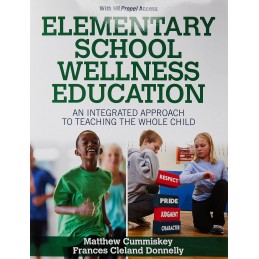Health education and physical education are traditionally siloed—for no good reason, according to authors Matthew Cummiskey and Frances Cleland Donnelly.
So, through
Elementary School Wellness Education, the two authors provide a blueprint, complete with lesson plans, for teachers to fuse health education and physical education into one elementary school class.
“Students should be educated in a more holistic manner,” says Cummiskey. “We applied the concept of school wellness education at the elementary level, which has components of both traditional health education and physical education.”
Elementary School Wellness Education offers the following::
- 37 detailed lesson plans for grades K-5 (19 lessons for K-2 and 18 lessons for grades 3-5) that are tied to SHAPE America Outcomes and National Health Education Performance Indicators
- Clear instruction on how to apply the plans, making it perfect for both preservice and in-service teachers
- More than 70 lesson plan handouts (with four-color graphics), available in the HKPropel platform, that are easy for teachers to print
- A test package, presentation package, and instructor guide that make this ideal for existing and emerging teacher education courses
A typical School Wellness Education (SWE) lesson combines classroom-based learning activities—such as discussions, worksheets, and videos—with physical activity. All the lessons in the book take place in the gymnasium, so theres no need for a separate health education classroom. In addition, the SWE approach helps teachers maximize their instruction time by meeting multiple learning standards simultaneously.
“The lessons are learning focused, with each activity carefully aligned to the objectives,” says Cleland Donnelly. “Moreover, theyre
fun. Students arent sitting in a traditional classroom learning health; theyre
doing it in the gym.” SWE also uses traditional PE equipment—and the gym—in new and creative ways, she adds. “This is especially important in schools that lack a separate health education classroom.”
Elementary School Wellness Education addresses emergent pedagogies such as skill-based education, universal design for learning, social and emotional learning, and social justice, helping both in-service and preservice teachers understand how to use and benefit from these pedagogical approaches. It also guides readers in how to teach wellness education online as effectively as face-to-face. Teachers will learn how to teach the content in person, online, or in a hybrid approach.
“The good news for teachers is that SWE is not a dramatic departure from existing instruction,” says Cummiskey. “Students are still moving and being taught in the gymnasium, but now health content and skills are being infused into all the lessons.”
The book, he says, is also suitable for use by classroom teachers looking to promote wellness or incorporate additional physical activity into their students days. “The intent is to imbue students with the knowledge, skills, and dispositions to lead a healthy life into and through adulthood,” he says.
Note:: A code for accessing HK
Propel is included with all new print books.




 Delivery policy
Delivery policy
 Security policy
Security policy
 Return policy
Return policy
